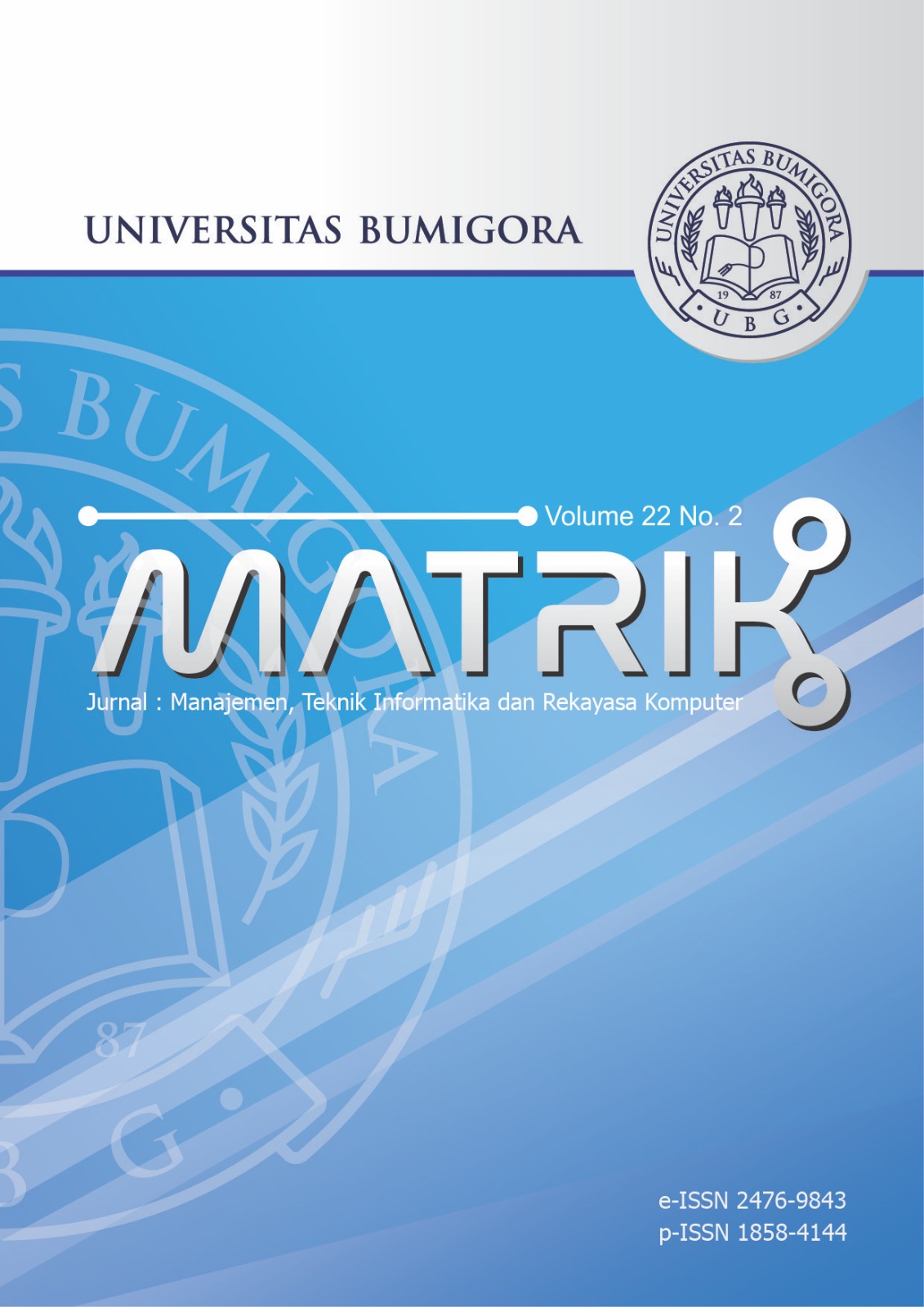A Novel Algorithm of Distance Calculation Based-on Grid-Edge-Depth-Map and Gyroscope for Visually-Impaired
DOI:
https://doi.org/10.30812/matrik.v22i2.2757Keywords:
distance calculation, gyroscope, grid-edge-depth-map, stereo camera, trigonometry formula, visually impairedAbstract
This paper presented a new algorithm for determining the distance of an object in front of a stereo camera placed on a helmet. By using a stereo camera with a Sum of Absolute Difference with a Sobel edge detector, our previous Grid-Edge-Depth map algorithm could calculate the objects’ distance up to 500 cm. The problem started when a vision disability person used the device with an unfixed stereo camera angle. The unspecified angle caused by the helmet’s movement influenced the distance calculation result. This novel process started with calculating the distance from a Grid-Edge-Depth map considering unfixed angle data of the x-axis from a gyroscope sensor placed on the stereo camera using the trigonometry formula. The angle data used was the x-axis data. The distance measurement results by the system were then computed based on the unfixed angle compared to the actual distance. The test was carried out with three scenarios which required the user to stand at a distance of 100 cm, 125 cm, and 150 cm from a table, chair, or wall, with 30 tests for each scenario. The test results showed an average accuracy of 96.05% with three experimental scenarios, which meant that this machine was feasible to implement.
Downloads
References
on Instrumentation and Measurement, vol. 70, 2021.
[2] E. J. Anthony and R. A. Kusnadi, “Computer Vision for Supporting Visually Impaired People: A Systematic Review,†Engineering,
MAthematics and Computer Science (EMACS) Journal, vol. 3, no. 2, pp. 65–71, 2021.
[3] S. Caraiman, O. Zvoristeanu, A. Burlacu, and P. Herghelegiu, “Stereo Vision Based Sensory Substitution for the Visually
Impaired,†Sensors, vol. 19, no. 2771, pp. 1–18, 2019.
[4] J. K. Mahendran, D. T. Barry, A. K. Nivedha, and S. M. Bhandarkar, “Computer Vision-Based Assistance System for the
Visually Impaired Using Mobile Edge Artificial Intelligence,†in IEEE Computer Society Conference on Computer Vision and
Pattern Recognition Workshops. IEEE Explore, 2021, pp. 2418–2427.
[5] J. Supriyanto and A. Fadlil, “Qualitative Testing of Earthquake Information Applications in The Form of Sound for the Visually
Impaired,†Matrik, vol. 21, no. 3, pp. 619–628, 2022.
[6] A. Sen, K. Sen, and J. Das, “Ultrasonic Blind Stick for Completely Blind People to Avoid Any Kind of Obstacles,†in Proceedings
of IEEE Sensors, vol. October. IEEE, 2018, pp. 1–4.
[7] A. A. Di´az-Toro, S. E. Campan˜a-Bastidas, and E. F. Caicedo-Bravo, “Vision-Based System for Assisting Blind People to
Wander Unknown Environments in a Safe Way,†Journal of Sensors, vol. 2021, pp. 1–18, 2021.
[8] N. Loganathan, K. Lakshmi, N. Chandrasekaran, S. R. Cibisakaravarthi, R. H. Priyanga, and K. H. Varthini, “Smart Stick for
Blind People,†in 2020 6th International Conference on Advanced Computing and Communication Systems, ICACCS 2020,
2020, pp. 65–67.
[9] S. Budilaksono, B. Bertino, I. G. A. Suwartane, A. Rosadi, M. A. Suwarno, S.W. Purtiningrum, Y. Sari, E. Suhandono, E. M. S.
Sakti, D. Gustina, and A. A. Riyadi, “Designing an Ultrasonic Sensor Stick Prototype for Blind People,†in 1st Bukittinggi
International Conference on Education IOP Conf. Series: Journal of Physics: Conf. Series, vol. 1471, no. 1. IOP Publioshing,
2020, pp. 1–7.
[10] R. Mehmood, “LidSonic V2.0: A LiDAR and Deep-Learning-Based Green Assistive Edge Device to Enhance Mobility for the
Visually Impaired,†Sensors, vol. 22, no. 19, pp. 1–55, 2022.
[11] J. Tong, J. Huang, V. Khou, J. Martin, M. Kalloniatis, and A. Ly, “Topical Review: Assessment of Binocular Sensory Processes
in Low Vision,†Optometry and Vision Science, vol. 98, no. 4, pp. 310–325, 2021.
[12] M. D. Messaoudi, B. A. J. Menelas, and H. Mcheick, “Review of Navigation Assistive Tools and Technologies for the Visually
Impaired,†Sensors, vol. 22, no. 20, 2022.
[13] B. Kuriakose, R. Shrestha, and F. E. Sandnes, “Tools and Technologies for Blind and Visually Impaired Navigation Support: A
Review,†IETE Technical Review (Institution of Electronics and Telecommunication Engineers, India), vol. 39, no. 1, pp. 3–18,
2020.
[14] M. Mashiata, T. Ali, P. Das, Z. Tasneem, F. R. Badal, S. K. Sarker, M. Hasan, S. H. Abhi, R. Islam, F. Ali, H. Ahamed,
M. Islam, and S. K. Das, “Towards Assisting Visually Impaired Individuals: A Review on Current Status and Future Prospects,â€
Biosensors and Bioelectronics: X, vol. 12, no. August, p. 100265, 2022.
[15] B. Rahmani, A. Harjoko, T. K. Priyambodo, and H. Aprilianto, “Early Model of Vision-Based Obstacle Mapping Utilizing
Grid-Edge-Depth Map,†International Journal of Engineering and Advanced Technology (IJEAT), vol. 9, no. 2, pp. 4519–4523,
2019.
[16] A. Jalal, A. Ahmed, A. A. Rafique, and K. Kim, “Scene Semantic Recognition Based on Modified Fuzzy C-Mean and Maximum
Entropy Using Object-to-Object Relations,†IEEE Access, vol. 9, 2021.
[17] A. A. Diaz, S. E. Campana, and E. F. Caicedo, “Methodology to Build a Wearable System for Assisting Blind People in
Purposeful Navigation,†in Proceedings - 3rd International Conference on Information and Computer Technologies, ICICT
2020, vol. 1, no. 1, 2020, pp. 205–212.
[18] J. Ganesan, A. T. Azar, S. Alsenan, N. A. Kamal, B. Qureshi, and A. E. Hassanien, “Deep Learning Reader for Visually
Impaired,†Electronics, vol. 11, no. 2225, pp. 1–22, 2022.
[19] P. Chandankhede, “Visually Impaired Aid Using Computer Vision to Read the Obstacles,†Journal of Algebraics Statistics,
vol. 13, no. 3, pp. 4467–4481, 2022.
[20] I. P. Adi, H. Kusuma, and M. Attamimi, “Blind People Guidance System Using Stereo Camera,†in 2019 International Seminar
on Intelligent Technology and Its Applications (ISITIA), 2019, pp. 298–303.
Downloads
Published
Issue
Section
How to Cite
Similar Articles
- Relita Buaton, Solikhun Solikhun, Application of Numerical Measure Variations in K-Means Clustering for Grouping Data , MATRIK : Jurnal Manajemen, Teknik Informatika dan Rekayasa Komputer: Vol. 23 No. 1 (2023)
- Mochamad Wahyudi, Solikhun Solikhun, Lise Pujiastuti, Gerhard-Wilhelm Weber, New Approach K-Medoids Clustering Based on Chebyshev Distance with Quantum Computing for Anemia Prediction , MATRIK : Jurnal Manajemen, Teknik Informatika dan Rekayasa Komputer: Vol. 25 No. 1 (2025)
- Paska Marto Hasugian, Devy Mathelinea, Siska Simamora, Pandi Barita Nauli Simangunsong, Comparative Evaluation of Data Clustering Accuracy through Integration of Dimensionality Reduction and Distance Metric , MATRIK : Jurnal Manajemen, Teknik Informatika dan Rekayasa Komputer: Vol. 24 No. 3 (2025)
- Ahmat Adil, ANALYSIS PROXIMITY MENENTUKAN LOKASI PERKEBUNAN DI LOMBOK BARAT , MATRIK : Jurnal Manajemen, Teknik Informatika dan Rekayasa Komputer: Vol. 15 No. 1 (2015)
- Debby Ummul Hidayah, Ika Romadoni Yunita, Gustin Setyaningsih, Evaluasi Website Kuliah Online STMIK Amikom Purwokerto Menggunakan Metode Heuristik (Studi Kasus Mata Kuliah Enterprise Resource Management) , MATRIK : Jurnal Manajemen, Teknik Informatika dan Rekayasa Komputer: Vol. 18 No. 2 (2019)
- F.ti Ayyu Sayyidul Laily, Didik Dwi Prasetya, Anik Nur Handayani, Tsukasa Hirashima, Revealing Interaction Patterns in Concept Map Construction Using Deep Learning and Machine Learning Models , MATRIK : Jurnal Manajemen, Teknik Informatika dan Rekayasa Komputer: Vol. 24 No. 2 (2025)
- Rakandhiya Daanii Rachmanto, Ahmad Naufal Labiib Nabhaan, Arief Setyanto, Deep Learning Model Compression Techniques Performance on Edge Devices , MATRIK : Jurnal Manajemen, Teknik Informatika dan Rekayasa Komputer: Vol. 23 No. 3 (2024)
- Ahmad Naufal Labiib Nabhaan, Rakandhiya Daanii Rachmanto, Arief Setyanto, Characterizing Hardware Utilization on Edge Devices when Inferring Compressed Deep Learning Models , MATRIK : Jurnal Manajemen, Teknik Informatika dan Rekayasa Komputer: Vol. 24 No. 1 (2024)
- Saiful Nur Arif, Muhammad Dahria, Sarjon Defit, Dicky Novriansyah, Ali Ikhwan, Implementation of Single Linked on Machine Learning for Clustering Student Scientific Fields , MATRIK : Jurnal Manajemen, Teknik Informatika dan Rekayasa Komputer: Vol. 22 No. 1 (2022)
- Samsurizal Samsurizal, Arif Nur Afandi, Mohamad Rodhi Faiz, Artificial Intelligence Enhanced Direct Current Fast ChargingIntegration for Electric Vehicles on 20 kV Grids: A Technical andOntological Study , MATRIK : Jurnal Manajemen, Teknik Informatika dan Rekayasa Komputer: Vol. 24 No. 3 (2025)
You may also start an advanced similarity search for this article.


.png)












